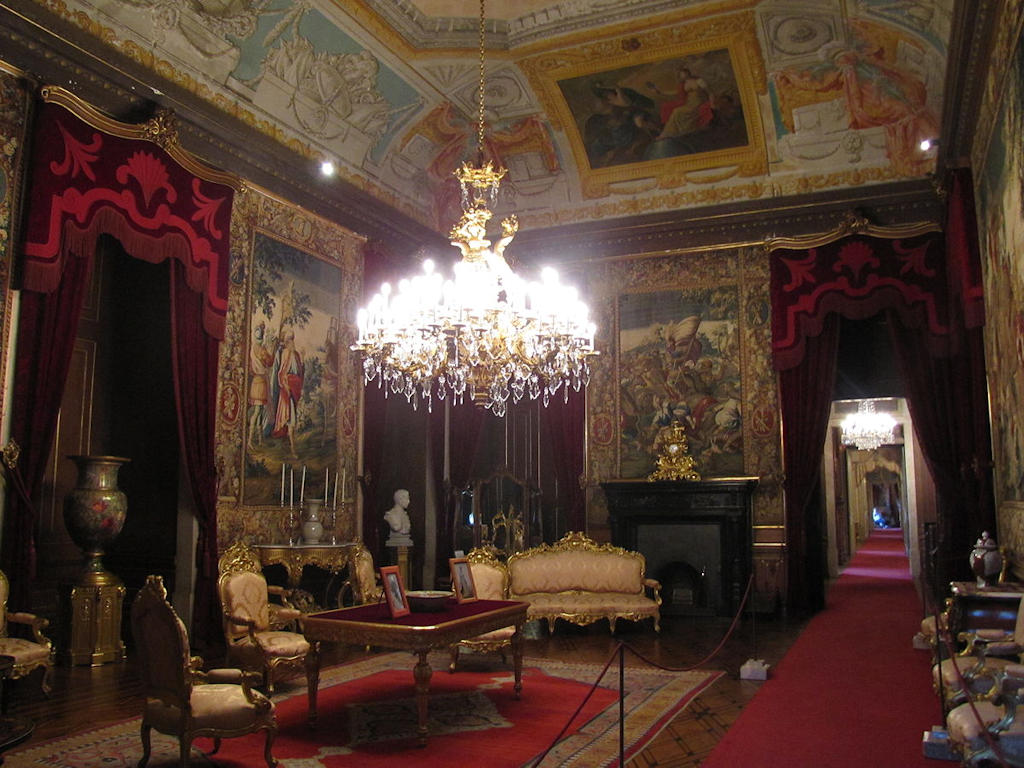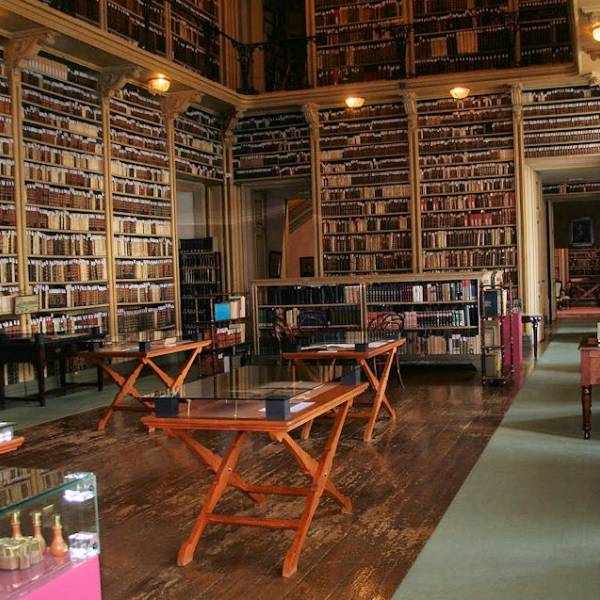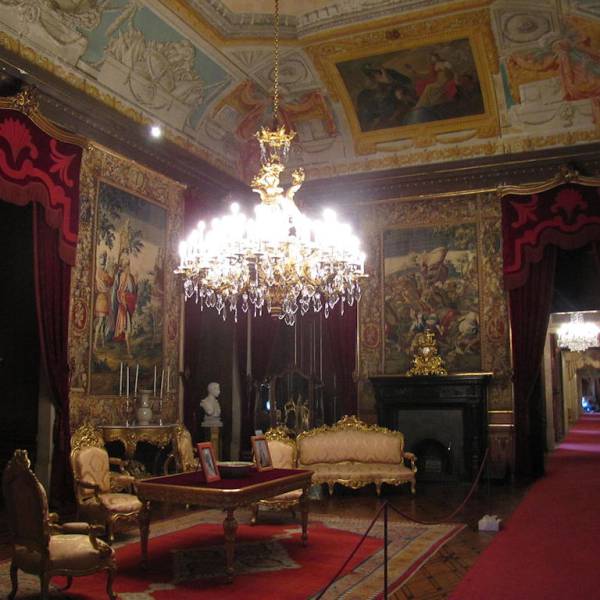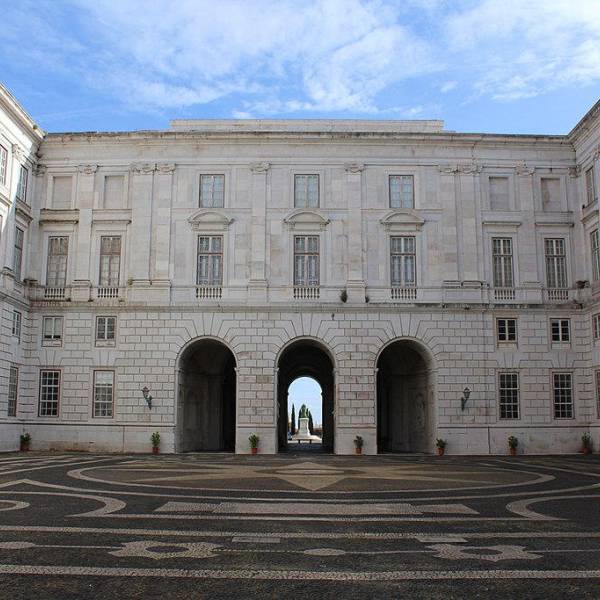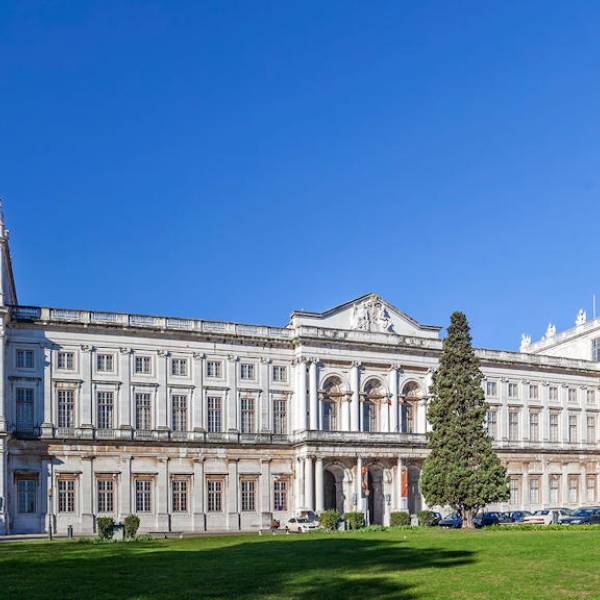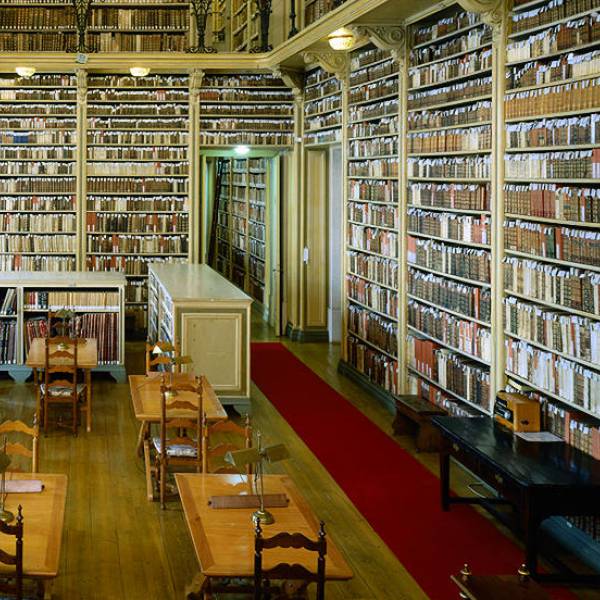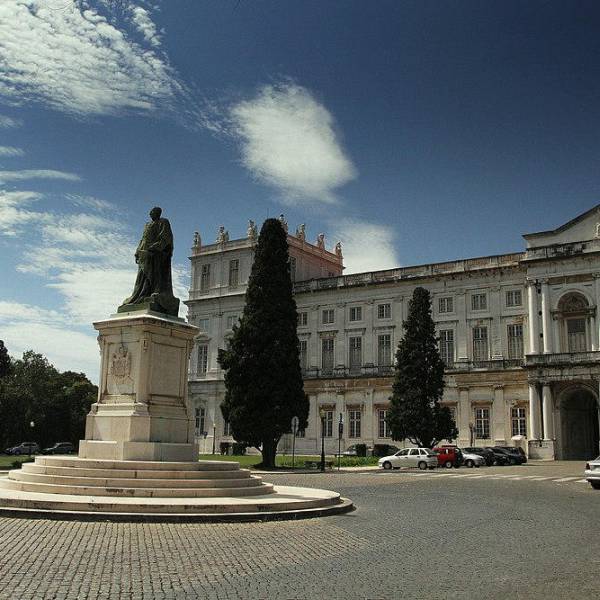First Floor
Sala dos Archeiros (Archer's Hall)
Named after the honor guard stationed there from 8:00 a.m. to 11:00 p.m., is a well-lit hall with two windows and three rectangular doors. These entrances are adorned with golden metal shields and decorative paintings depicting military victories. The vaulted ceiling of the hall, painted by José da Cunha Taborda, displays the Portuguese Royal coat of arms. The windows and doors are embellished with paintings, and the partially carpeted parquet floor adds to the hall's grandeur. Currently, this hall serves as the main entrance for visitors to the Palace and the concierge's desk.Sala do Porteiro da Cana (Cane Concierge Hall)
Also known as the Hall of Announcement, was used to announce visitors. It features a false cupola with square shapes, supported by plain columns and Corinthian capitals. At the center of the hall, there is an allegorical representation of Justice, flanked by two medallions depicting John IV and Carlota Joaquina. The hall is adorned with parquet floors.Sala das Tapeçarias Espanholas (The Spanish Tapestry Hall)
Also referred to as the Canopy Room or the Audience Hall, houses eight Spanish tapestries of varying sizes. These tapestries depict themes such as dance, walking in Andaluzia, card games, fountains, lunch, departure for the hunt, return from the hunt, and huntsmen. King Luís and Queen Maria Pia used this hall as a waiting room for formal guests. The semi-vaulted ceiling features an allegorical mural representing King John IV's departure for Brazil. The hall also contains various paintings, architectural elements, wooden cornices, and a parquet floor. Additionally, the hall is furnished with a large desk, gold-leaf wooden chairs covered in red velvet, and polished crests with chiseled bronze elements.Antecâmara da Sala do Despacho (The Antechamber of the Hall of Order)
Also known as the Hall of Dom Carlos' Painting or Dom Sebastian's Hall, is a small room. Its ceiling is painted with the figure of Diana and scenes from the hunt, while representations of Mercury, Vulcan, Science, and Peace adorn the doors.Sala do Despacho (The Hall of Order)
Another room used for state functions and official duties, has a flattened vaulted ceiling. The ceiling is painted with depictions of Aurora bringing Public Happiness, Abundance, Lies, and Justice. The room features military motifs on its moldings. An Italian black marble fireplace/stove is situated on one side of the room, adorned with two Ionic columns, a frieze with floral ornamentation, and a metal fireguard. The parquet floor is arranged in a geometric pattern. The room is decorated with gold-velvet chairs, large vases, lowboy furniture, and a red-velvet-topped table.Sala dos Contadores (The Accountants Hall)
Also known as the Lowboy/Chest of Drawers Room, is a small passage with inlaid parquet.Sala de Música (The Music Room)
Has a rectangular ceiling painting in sepia, white, and gold tones. Eight medallions representing the arms of Portugal and the Dukes of Braganza, as well as crosses of the military orders, are displayed. The walls are covered in pink silk, and the floor is adorned with parquet. An enormous oak wood fireplace/stove is situated at one end of the room. Glass display cabinets with ornate friezes and cornices are aligned on either side of the fireplace/stove. Musical instruments are displayed in the center, surrounded by velvet-lined bunk seating and several paintings.Quarto do Rei D. Luís (King Luís's Room)
Covered in white and gold painted wood-paneled wainscoting, retains its original un-restored wall colors. The painted ceiling depicts an allegorical representation of Peace by Cyrillo Volkmar Machado, featuring figures, mythical figures, and flowers in each corner. The main ceiling resembles an open-air cupola. The walls are simply painted in white with gold trim, divided into square panels. The parquet floor complements the room's design. The room is furnished with an ornate bed, table, white-velvet chairs, and a writer's desk. Statues stand in the window niches on the opposite wall from the bed. Paintings of Portuguese monarchs adorn one of the walls, while a full-size painting of King Carlos of Portugal hangs above the desk.Antecâmara do Quarto Real (The Antechamber of the Royal Bedroom)
Continues the wainscoting and painted friezes found in the main bedroom, adorned with coiled phytomorphic elements that repeat at a higher level on the walls.Sala Azul (The Blue Room)
Despite its name, is not actually blue. It is covered in white and gold silk walls and drapery, with matching chairs and a cushioned sofa on a parquet floor. This room was remodeled by Possidónio da Silva between 1863 and 1865 to serve as a Royal sitting room in Queen Maria Pia's preferred style. The room includes visual effects that create a proportioned space, such as two grand mirrors on opposite walls and a Romanesque arch opening that extends the view into the neighboring Oak Cabinet annex.Gabinete de Carvalho (The Oak Cabinet)
An annex that once served as a smoking room during a period when men and women socialized separately, is trimmed in oak. It features red-velvet drapery and chairs, adorned with paintings of King Luís's favorite ships, as well as an oak chest of drawers.Jardim de Inverno (The Winter Garden)
Also known as the Marble Hall, is covered in marble and agate gifted to the Royal Family by the Portuguese Viceroy to Egypt. It includes a Carrara marble fountain with a tank and pinnacle structure. Bronze cranes, busts, two large ornate bird cages, vases, and cushioned chairs reminiscent of outdoor furniture surround the fountain. Potted and hanging plants contribute to the impression of an enclosed outdoor environment.Sala Cor-de-Rosa (The Pink Room)
The Pink Room, a small room covered in pink silk, was specifically created to display the Queen's porcelain collection. Many figurines are showcased on sills along the walls, and the furniture is either painted pink or covered in pink velvet.Sala Verde (The Green Room)
Clad in green silk, features a white painted ceiling with golden elements and decorative paintings, including a large 1876 portrait of the Royal Family by Joseph Fortuné-Séraphin Layraud. The room's green drapery complements the parquet floor with geometric elements. A large Rococo-style white marble fireplace/stove adorns one wall, embellished with golden phytomorphic elements and the arms of Portugal. The room served as a private space for the Queen to conduct official duties or receive visitors. It was also where she gave birth to the royal heir, Prince Carlos. A small antechamber to the left, known as the Red Room, had various uses throughout history, including a washroom, oratory, workroom, or writing room. It currently displays portraits, busts, a chest of drawers, and a writing table.Sala de Saxe (The Saxe Room)
The Saxe Room is lined with silk and features a plaster ceiling adorned with flowers, birds, and butterflies. It currently exhibits toys and objects associated with Infantes Carlos and Afonso. This room is located to the right of the Green Room, and it once displayed Portuguese medallions and paintings of Italian landscapes.Quarto da Rainha (Queen's Bedroom)
Queen's Bedroom, decorated in the Napoleonic style of 1861, features walls covered in blue silk with a silver pattern. The ceiling is painted with allegorical depictions of Faith, Hope, Charity, and John the Baptist. The room is adorned with religious iconography, ornate wood furniture, and a large canopy bed in blue, gold, and silver colors. The carpeted floor includes a polar bear hide. Adjacent to the bedroom is the "toucador," a changing room and toilette. It continues the carpeted space from the bedroom and features a large three-pane standing mirror, a fireplace, a chest of drawers, and a commode. The room is decorated in rich brown and gold trim with phytomorphic elements and paintings of Diana, Juno, Venus, and Minerva over the doorways. The actual bathroom, while more practical than decorative, includes painted moldings, rich wood trim, a bathtub, double lavatory, double sink, and bidet. These hygienic innovations were imported from England around 1880.A Casa de Jantar da Rainha (Queen's Dining Room)
Queen's Dining Room, a private dining room not originally planned in the 1802 design of the Palace but added by 1880, is decorated in red silk and rich wood grain trim from floor to ceiling. It features a wood fireplace/stove on one wall, surmounted by a large mirror. The opposite wall provides an entrance to the adjacent Billiard Room. The floor is covered with inlaid parquet and adorned with a bronze lustre.Sala de Bilhar (The Billiard Room)
Replaced an older room on the second floor and was where King Luís would retire after dinner while the Queen and guests would gather in the Blue Room. Occasionally, the Queen would join the King for a game or play with her piano teacher, Mrs. Cart. The room is an elaborate extension of the adjacent Dining Room, featuring a parquet floor, a wood fireplace, lateral wooden pilasters, and dark wood grain-colored walls. Long bunk sofas line the walls, and a large carved wood fireplace with cherubs and a built-in mirror serves as the centerpiece. The central pool table occupies most of the space.These various rooms within the Palace showcase exquisite design, opulent furnishings, and historical artifacts, providing a glimpse into the rich history of the Portuguese monarchy.


